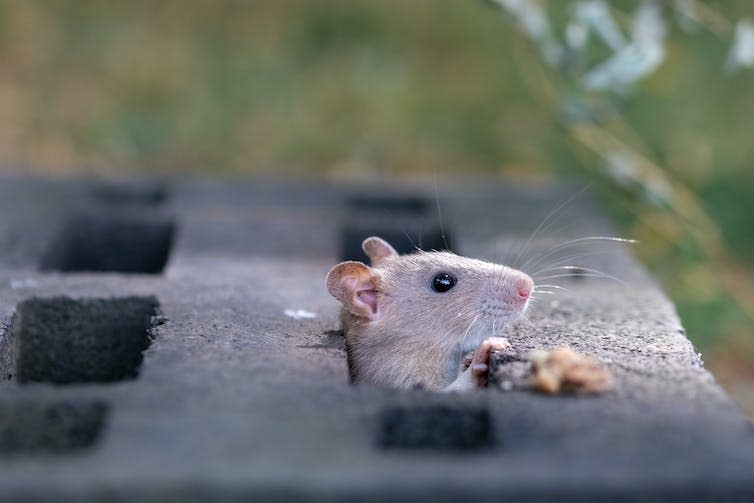Mice have an unfortunate tendency to enjoy living where humans live. This is how a biologist tried to explain people’s hatred of rodents in a television news report about rats gnawing the electrical wiring of parked cars in the southern Swedish town of Malmö.
brown rat, Rattus norvegicusIt is one of the species best adapted to modern society. These mice have become one of the most abundant mammals, following humans around the world; Spreading from native distributions in northern China and Mongolia, it reached Europe in the 1500s, possibly even earlier. But black rats came to Europe in the early 1st century AD.
Today, nearly all wild brown mice are synanthropic, meaning they live in close association with humans, eating our leftovers and using human structures as shelter. The relationship between mice and humans is one of commensalism, a word derived from the Latin term “commensal” meaning “eating at the same table.”
For centuries, mice have been seen as humanity’s dark shadow. Rats have had a tremendous impact on human civilization, particularly through the spread of diseases. They have long been associated with dirt, death and destruction. In medieval Europe, people hated rats for their supposed ferocity, seemingly limitless sexual appetite, and fertility. But their large numbers and adaptability reflect the evolutionary success of humans.
Through wars and European imperialism, they spread to colonized areas in the Americas as well as Africa and Australia. Even today, rats persist in modern war trenches.
A social and empathetic animal
Real rats are far from the vile creatures they are often portrayed as. Many studies have shown that mice have strong empathy.
These animals can share the emotional state of others, which is called emotional contagion in psychology. Research has shown that when a rat sees another rat in distress, the neural structures activated in that rat’s brain are very similar to those activated in the human brain when it empathizes with the pain of others.
One experiment showed that mice will release other mice from an unpleasant cage, even if they are not rewarded. And if a chocolate treat was given afterwards, the free mouse usually kept at least one treat for the former captive.
This altruistic behavior results from mice’s socially complex lives in multigenerational family groups. They form lifelong bonds with other mice and share socially learned skills, such as foraging techniques, across generations. This means that mice have some form of culture.
A 2023 study even showed that mice can imagine places and things that are not currently in front of them. In experiments, mice were shown to wander in their thoughts in an area they had previously explored. As with empathy studies, the researchers demonstrated this by comparing the regions activated in the brains of mice with the regions activated when humans think about finding their way around the places they visit.
This ability to imagine also suggests that mice have a sense of the past and future.
To live and die with mice
With this in mind, the ways people deal with rats seem cruel. The most common chemical method for mouse control is anticoagulants, which cause fatal internal bleeding one to two weeks after the mouse ingests the poison. Because mice are both socially intelligent and cautious, they prefer to taste unfamiliar food and wait to see if it makes them or other mice sick.
This is called toxic shyness. However, with anticoagulants, the time between the consumption of the bait and the death of the mouse is so long that they often do not associate it with feeding habits.
People’s motivation for learning about rats has often been the desire to kill them. The foremost experts on wild mouse behavior are their exterminators. But still, current methods for controlling wild mouse populations are not very effective.
Some mice have developed resistance to the poison and are able to eat it and survive. They are known to be quite difficult to trap and will often re-colonize the area from which they were removed.
Global urbanization will likely only bring humans into closer contact with rats, and killing rats in this way today is unethical.

Instead, we should consider other strategies, such as those researched by the Urban Mouse Project at the University of Helsinki. Here, researchers from different disciplines are trying to understand more deeply the conflicts between mice and humans. They study both species and their interactions in hopes of a future with less bloody human-mouse relations. The project found that places in urban areas where people feed birds also attract rats, and that people try to eliminate rats by using poison or traps.
Research has also suggested that with increasing knowledge about mice and their behavior, people tend to develop a more positive attitude towards them. Therefore, more information is needed about the social behavior of wild mice. And people need to manage their own behavior to avoid conflict with rats.
A good place to start would be to reduce food waste and stop leaving leftovers unsecured. For example, fewer mice around human food sources and more knowledge about their behavior will mean a reduced risk of diseases spreading from mice to humans and from people to mice.
The future of humanity lies with the mouse, a social and empathetic animal. It’s time to understand our shadows.
This article is republished from The Conversation under a Creative Commons license. Read the original article.


Tobias Linné does not work for, consult, own shares in, or receive funding from any company or organization that would benefit from this article, and has disclosed no relevant affiliations beyond his academic duties.